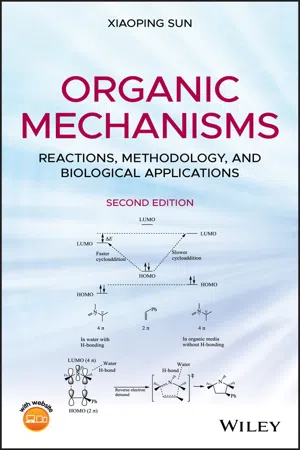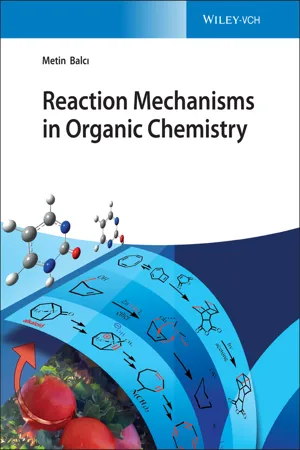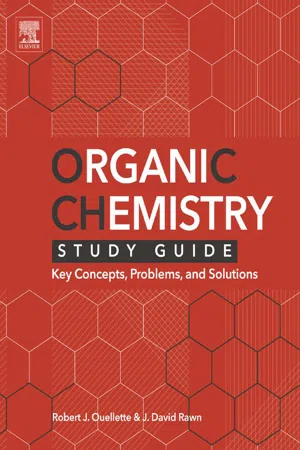Chemistry
Alcohol Elimination Reaction
Alcohol elimination reaction is a chemical process in which an alcohol molecule is converted into an alkene or an alkyne by the removal of a water molecule. This reaction is typically carried out in the presence of a strong acid or base catalyst and can be used to synthesize a variety of organic compounds.
Written by Perlego with AI-assistance
Related key terms
Related key terms
1 of 4
Related key terms
1 of 3
3 Key excerpts on "Alcohol Elimination Reaction"
- eBook - ePub
Organic Mechanisms
Reactions, Methodology, and Biological Applications
- Xiaoping Sun(Author)
- 2020(Publication Date)
- Wiley(Publisher)
Fig. 7.6 ).Figure 7.21 shows reaction profiles for E1 elimination of 2‐halo‐2‐methylbutane (RX, X = Cl, Br, or I) [2 ]. The order of standard bond dissociation energies (BDEs ) for C─X bonds is BDE (C–Cl, 327 kJ/mol) > BDE (C–Br, 285 kJ/mol) > BDE (C–I, 213 kJ/mol) (see Section 6.1 ). The relative energy levels of R–Cl, R–Br, and R–I are placed accordingly in their reaction profiles. For each of the haloalkanes, the rate‐determining step of E1 reaction (the formation of a carbocation) has a very late transition state. Its structure greatly resembles the carbocation. Therefore, the transition states for all the haloalkanes have very similar energies. As a result, the activation energy of the rate‐determining step for RX almost solely depends on BDE of the C─X bond as indicated in Figure 7.21 (Ea,RCl > Ea,RBr > Ea,RI ). This means that rate of the overall reaction is determined by relative ease of departure for the functional group. A better leaving group makes the reaction faster. This is a general principle governing the elimination reactions. On the other hand, the regiochemistry for the E1 reactions is dictated by the relative stabilities of the alkene products. Alkene (1) is more stable and is formed as the major product, as the product formation step for the more stable alkene (which has a lower energy level) possesses a smaller activation energy and is more productive.Reaction profiles for E1 reactions of haloalkanes.FIGURE 7.217.7 THE E1 ELIMINATION OF ETHERS
Analogous to acid‐catalyzed dehydration of alcohols (ROH), in the presence of a strong acid, elimination can also occur to secondary or tertiary alkyl ethers (ROR′). Especially interesting is the acid‐catalyzed elimination for tertiary butyl ethers (tBuOR, R is a primary or secondary alkyl group) (Fig. 7.22 ) [1 - eBook - ePub
- Metin Balc?, Metin Balc?, Metin Balc?, Metin Balc?, Metin Balc?(Authors)
- 2021(Publication Date)
- Wiley-VCH(Publisher)
On the other hand, if the β-carbon from which a proton is to be removed is bonded to two hydrogens, two configurational isomers of an alkene can be formed. The carbocation created in the first step has a planar structure. Now, elimination can proceed with one of these two β-protons forming both the E and Z products. For example, (2-chloropentan-2-yl)benzene reacts with the base to eliminate hydrogen chloride to create two different olefins. Elimination in which cis - and a trans double bonds are formed is called stereogenic elimination. trans -Alkenes are more stable than their cis -isomers because of the nonbonded interaction strain between alkyl groups on the same side of the double bond in the cis - isomers. The ratio of cis - and trans -products depends on the reaction mechanism. In E1 reactions, this ratio is determined by the transition state. The first step is the formation of a carbocation. For elimination of the β-proton, the C—H bond from which the proton will be eliminated and the empty p orbital must align parallel to form the C=C double bond. The cis - transition state always has higher energy than the trans - transition state because of steric repulsion between the substituents. The double bond formation takes place “preferentially via the lower energy pathway,” which leads to the formation of the trans - isomer (Figure 3.3). Figure 3.3 Energy profile of cis - and trans -transition states in E1 elimination reactions. ΔE 1 is the energy difference between two transition states and ΔE 2 is the energy difference between the olefins. 3.1.1.1 Dehydration of Alcohols Elimination of a water molecule from alcohols is a dehydration reaction. This reaction requires an acid as a catalyst to convert the hydroxyl groups into a good leaving group. Mineral acids, as well as Lewis acids, are used for H 2 O elimination. t- Alcohols easily undergo elimination and form alkenes. If there is more than one adjacent carbon atom, a mixture of alkenes is formed - eBook - ePub
Organic Chemistry Study Guide
Key Concepts, Problems, and Solutions
- Robert J. Ouellette, J. David Rawn(Authors)
- 2014(Publication Date)
- Elsevier(Publisher)
Since undesirable rearrangements occur in acid-catalyzed reactions of alcohols, other methods have been developed to synthesize alcohols that do not require acid. In this section, we discussed two additional reagents that convert alcohols to haloalkanes. They are used for secondary and primary alcohols which react slowly with hydrogen halides.Thionyl chloride is used to convert alcohols to chloroalkanes. The by-products are sulfur dioxide and hydrogen chloride, both of which escape from the solution as gases. Phosphorus tribromide is used to convert alcohols to bromoalkanes. The by-product, phosphorous acid, is soluble in water.9.14 Elimination Reactions
The elimination reactions we consider result in loss of atoms from adjacent carbon atoms and is called a 1,2-elimination or a (β-elimination). β-Elimination reactions occur by either E1 or E2 mechanisms. An E1 mechanism is similar to an SN 1 mechanism in one key respect: it is a unimolecular reaction in which a carbocation intermediate forms in the rate determining step. And, as in SN 1 reactions, the carbocation can, and often does, rearrange to give several products. E1 reactions typically occur in the dehydration of tertiary alcohols. E1 reactions compete with SN 1 reactions. E2 reactions, like SN 2 reactions, are bimolecular processes in which there are two species in the transition state. E2 reactions are observed for primary and secondary alkyl halides and alcohols. The reactions of alcohols in both E1 and E2 reactions are acid catalyzed.9.15 Regioselectivity in Dehydrohalogenation
Dehydrohalogenaton occurs to give a predominance of the most substituted alkene. This regioselectivity results in the so-called Zaitsev product. This product is the most stable alkene. The alkene with the most alkyl groups bonded to the carbon atoms of the double bond is favored. If geometric isomers are possible, the more stable trans isomer predominates.9.16 Mechanisms of Dehydrohalogenation
There are two mechanisms for dehydrohalogenation. The E2 reaction occurs for primary haloalkanes and usually for secondary haloalkanes. The E1 process occurs with tertiary haloalkanes. In either case, the rate depends on the leaving groups. The reactivity order is iodo- > bromo- > chloroalkane.
Index pages curate the most relevant extracts from our library of academic textbooks. They’ve been created using an in-house natural language model (NLM), each adding context and meaning to key research topics.
Explore more topic indexes
Explore more topic indexes
1 of 6
Explore more topic indexes
1 of 4


